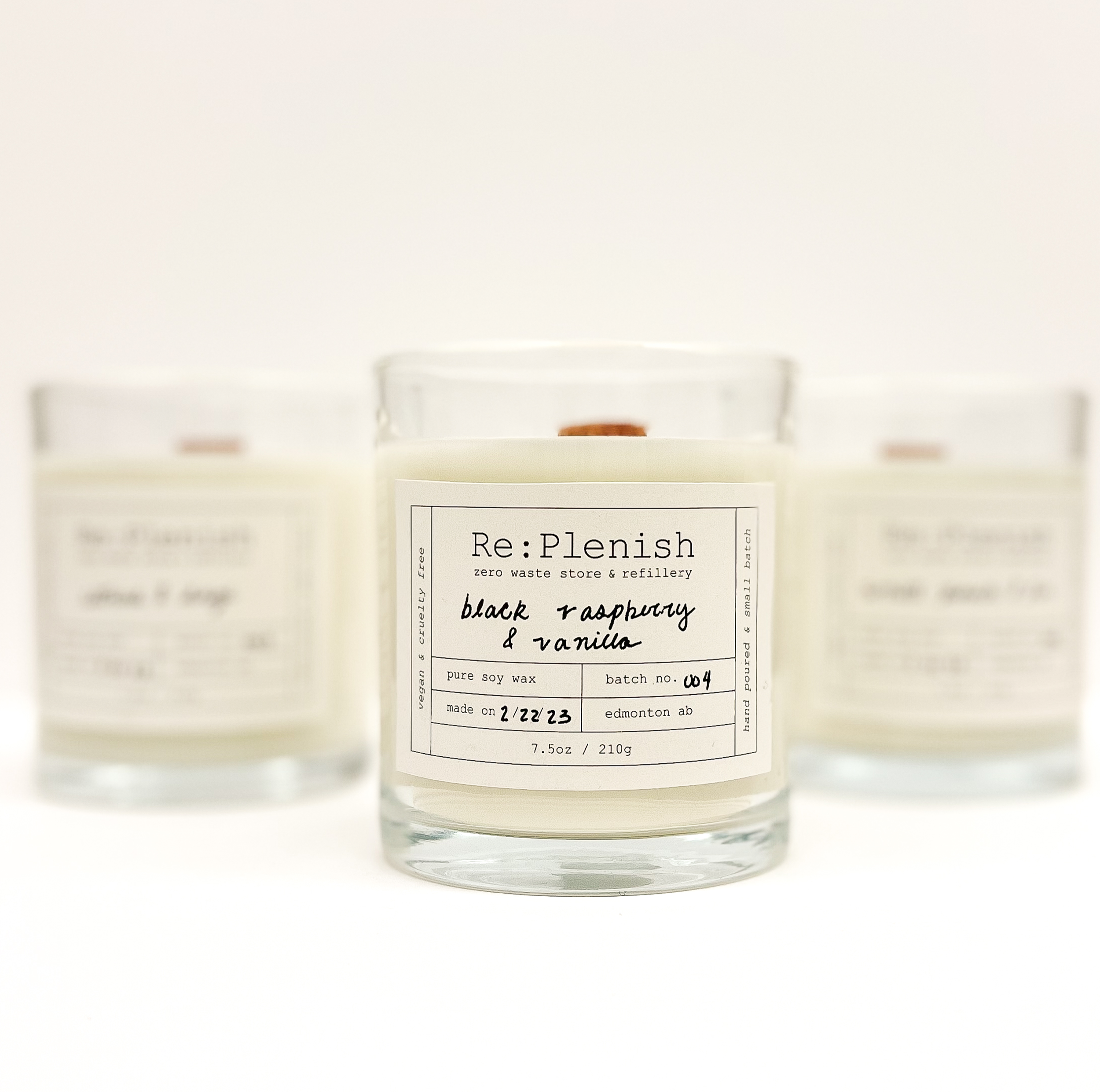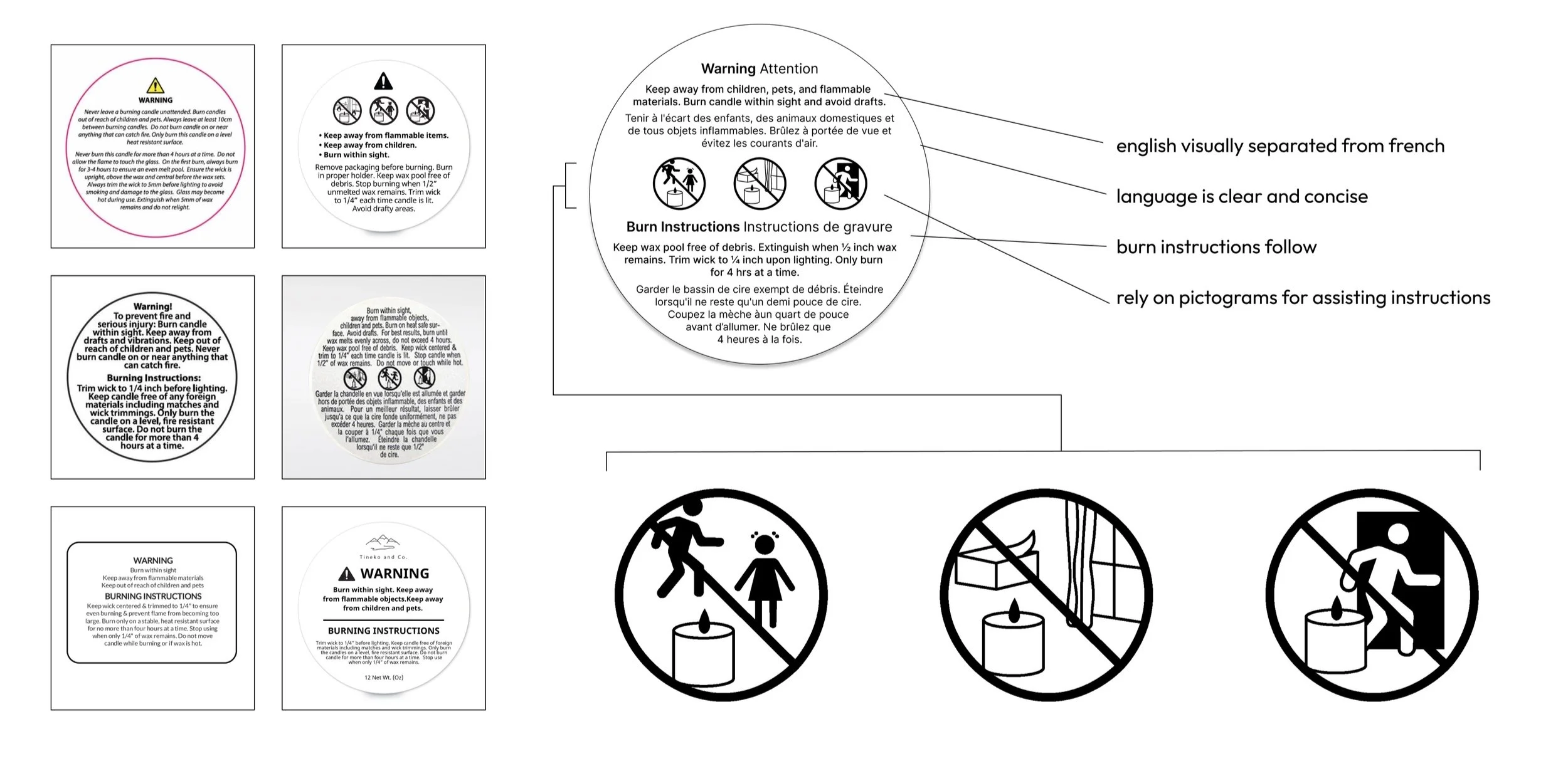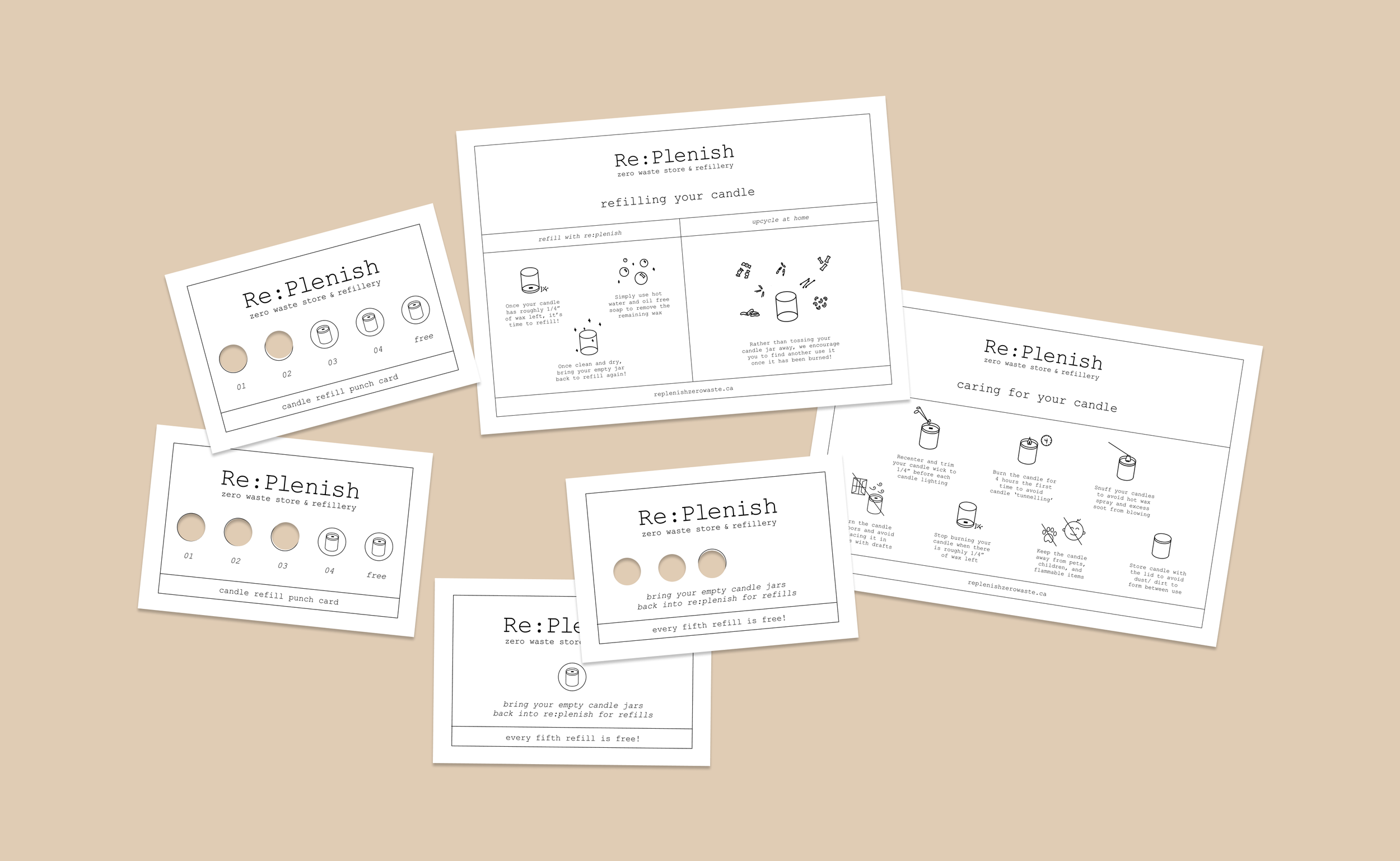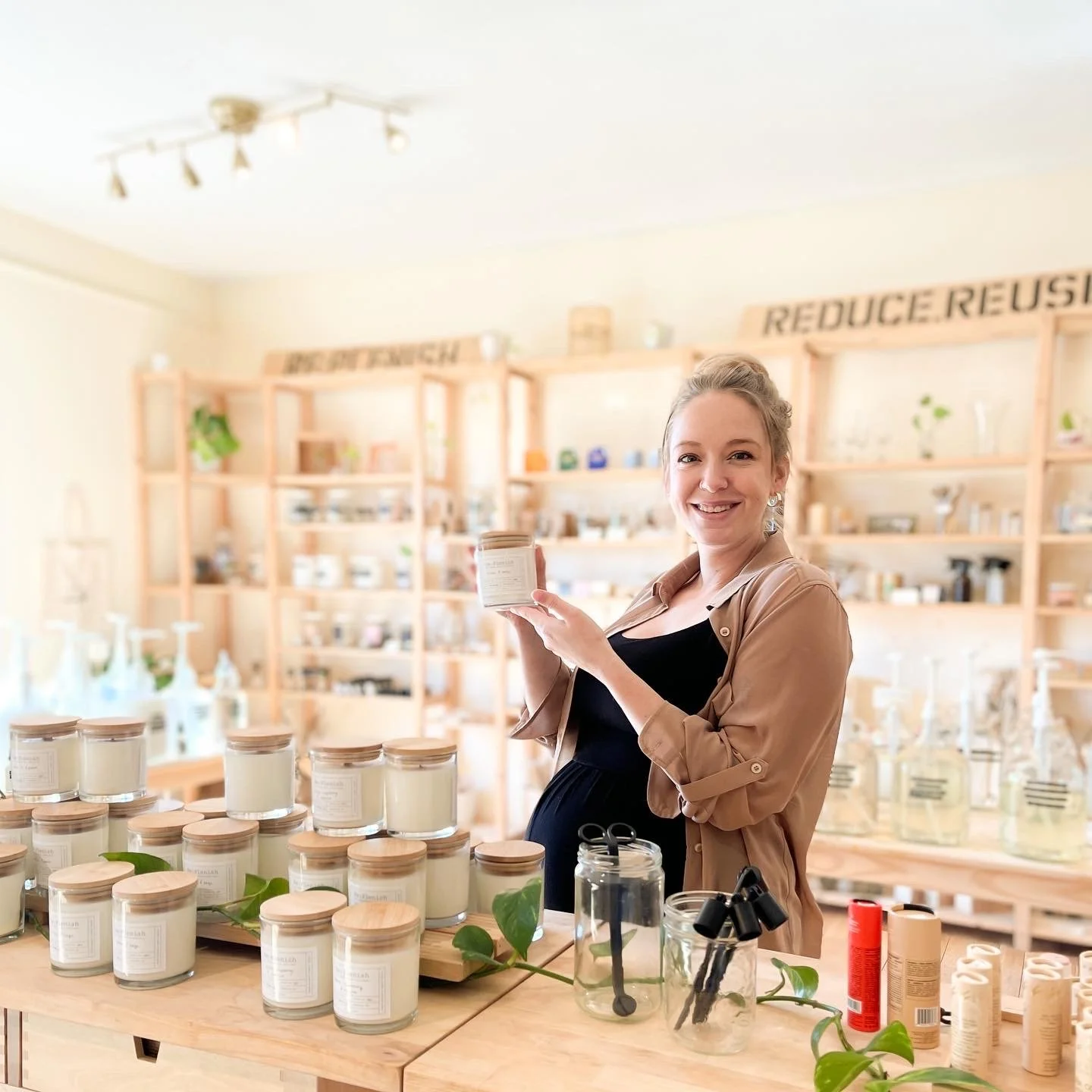Zero Waste Candle Refill Service
Project Overview
For my sustainability capstone project, I collaborated with Re:Plenish Zero Waste to create ethical candles to add to their refill service. This initiative also examined the luxury market's role in overconsumption and the waste crisis in Western society. Through research and design, I aimed to produce a product that aligns with the ethical values of Re:Plenish and the Edmonton Zero Waste community. Ultimately, this project highlights the importance of sustainable choices and the role of producers in promoting safer products through thoughtful design, encouraging discussion on responsible consumption, and staying mindful of our environmental impact.
Role
Designer
Project Date
February – May 2023
Client
Re:Plenish Zerowaste & Refillery
University Sustainability
Capstone Project
Involved
Design Research
Sustainable Product Design
Information Design
Systems Thinking
Project Details
-
The goals of this project were to research, source, and design sustainable and ethically-based candles for the local community. This involved examining how materials and ingredient choices for products could have larger implications for both people and the planet. This also entailed examining how luxury goods such as candles have contributed directly and indirectly to overconsumption and our growing waste problem. Through this project, I aimed to explore how ethical products can be produced at a local scale, encouraging both consumers and producers to play a key role in shifting our community towards safer, cleaner, and more ethical products.
The sourcing of materials focused on renewable resources, ensuring derivatives that minimized environmental impact. The selection of wicks and waxes involved evaluating options like soy or beeswax, which present a more sustainable alternative to traditional paraffin. Additionally, fragrance components were chosen to be phthalate-free, maintaining a commitment to both environmental health and consumer safety.
To address the luxury aspect of candles, I analyzed consumer behaviors that contribute to overconsumption, particularly the marketing of candles as luxury items rather than everyday products. The aim was to redefine their role in the market, promoting them instead as essential sources of comfort and ambiance that do not sacrifice sustainability for luxury.
Community engagement was a crucial component of this project. Workshops and information sessions were organized to educate consumers about the benefits of choosing ethical products, encouraging an active dialogue around consumption choices, and fostering a community culture that prioritizes sustainability. Ultimately, the project seeks not only to provide quality products but to inspire a local movement towards conscientious consumerism that reflects a thoughtful approach to the products we use in our daily lives.
-
The solution for this project consisted of designing Re:Plenish's eco-friendly candle line to sell at their shop using sustainable ingredients, quality materials, and eco-friendly packaging. It was also essential to consider how this product could be reused; therefore, a possible refill program was envisioned to incentivize consumers to reuse the container, significantly reducing their waste after burning their candles.
-
Identify the need, challenge, and define the target audience
Conduct interviews to empathize with the user
Research overconsumption and outgrowing waste problem
Conduct a literature review to frame my work
Source candle materials in accordance with materials research and findings
Redesign existing warning labels to improve accessibility
Design remaining print materials with a suite of icons for future use.
-
The user need came from a recent gap in the local market as their previous candle supplier had closed her business. They received an influx of comments from customers to create or find a new line to carry in their store, expressing a need to fill this gap.
The challenge for this project was to create refillable candles that consumers would want to buy and to incentivize how they could engage with the product once the candles have been burned, such as refilling the candle or upcycling the container.
The target audience includes those between the ages of 18–55 who value sustainable candles and making eco-friendly decisions. To target these consumers, I will promote the candles online as well as in-person in Re:Plenish, where they will be sold. The consumer base is largely eco-friendly folks between the ages of 18–55 who already opt for sustainable practices. However, we aim to have a larger impact on the growing eco-community, thus appealing and catering our design to be inclusive for those who are new to sustainability and conscious products is a top priority.
-
The literature review provided significant insights into the interconnectedness of overconsumption, ingredient toxicity, and sustainable candle design.
Overconsumption: The research highlights that while not all resource consumption leads to environmental harm, the majority takes place within a consumer-driven society, resulting in irreversible exploitation of resources (Brown, 2015). This finding underscores the need for mindfulness in consumption practices.
Ingredient Toxicity and Health Impacts: The emissions from burning candles, including various pollutants such as black carbon, ultrafine particles, and polycyclic aromatic hydrocarbons, pose health risks.
I used this research to create a foundation for my work and to examine the ways in which this project interacts with multiple levels of sustainability through both large and small-scale environmental concerns. Some highlights from this literature review were:
Although not all resource consumption is inherently damaging or the sole cause of our eco-decline, a large majority of resources are irretrievably exploited within our “consumer society” (Brown, 2015).
Research conducted and reported by Andersen found that “burning candles emit particle and gas-phase pollutants” such as “aerosol soot particles (black carbon [BC]), 1-3 ultrafine particles (UFPs), 4-7 polycyclic aromatic hydrocarbons (PAHs), 8 and NOx.9-11” (2021). Thus, it’s important to select candles that have optimized wax and wick compositions that can reduce toxic emissions, obtaining the “lowest possible emissions of eBC, PM2.5, and particle-phase PAHs” (Andersen, 2021).
Certain design decisions can certainly impact the sustainability of a product. For instance, a “product with an unchanging design [...] best suited for reuse” (Cooper, 2015) can increase the reusability of a product or component.
By improving the longevity of the product – in this case, ensuring the reusability of the candle container once it has been burned (or in its ‘use phase’) – its environmental impact will be reduced (Leismann, 2013).
-
I conducted two interviews to begin this design process. One with a self-identified “eco-enthusiast”, and one with someone who was interested in candles, but wasn’t as familiar with concepts like over consumption and excess waste from luxury items such as candles. These two interviews helped me formulate my user personas: The ‘eco-champion’ and the ‘newbie’.
The Eco Champion: Reese
Reese is a long-time environmentalist who enjoys spending time outside with her dog. She also values quality and long-lasting items that she knows are safe for her and the planet.
Reese's goals:
Find a candle that is made with clean ingredients and natural products
Reduce her individual waste by choosing reusable products
Support her local economy and shop small
Pain points:
Dislikes when candles have harsh scents that are harmful to her and her dog
Wishes she could reuse her saved containers in a more effective way.
The Newbie: Nora
Nora is new to eco-friendly swaps and wishes to live more mindfully. She enjoys going to farmers' markets and is interested in finding ways to be more sustainable without compromising quality.
Nora's goals:
Learn more about the ingredients in her products
Find ways to be more eco-friendly besides simply recycling
Source more conscious products and make long-lasting swaps
Pain points:
Wants to find products that are eco-friendly without compromising on appearance and fragrance
Hates when candles use artificial fragrances or release a lot of soot/smoke into the airs
Re:Plenish Candle
Candle showing warning label design with lid
Materials and Sustainability
For this project, it was clear that Re:Plenish needed a candle that used fresh, natural ingredients and long-lasting materials. This was important not only for Re:Plenish, but also for their growing customer base that values eco-friendliness. To create a highly eco-friendly candle, we sourced the following materials:
Container: Refillable clear glass vessel with 100% natural bamboo lids
Labels: Recycled, acid-free paper printed with soy-based ink
Wax: 100% natural soy wax made from soybeans grown in the US, which is vegan and cruelty-free
Fragrance: Scented with natural, IFRA certified, high-quality fragrance that is phthalate-free, vegan, and cruelty-free
Wick: 100% wooden wicks, free from mushrooming, with little carbon buildup, debris, or sooting
Warning Label and Project Label Design
In addition to creating the candle, I designed labels that provide essential product information and warning labels to enhance health and safety measures. This included researching existing label designs and improving them by adding French and English translations, as well as using more accessible illustrations.
Warning Label
Product Label
Adding Incentives
To enhance the sustainability of our candle product line and encourage customer participation, we have developed an incentive program aimed at promoting the refill and reuse of candle containers. The goal is to motivate customers to return their used containers not only for environmental benefits but also through immediate rewards. Through the following initiatives, we aimed to create a cycle of sustainability that benefits both our customers and the environment, fostering a community that values reusability and eco-conscious living.
Monetary Reward: Customers who bring back their used candle containers will receive a discount on their next purchase or a complimentary refill, demonstrating our appreciation for their commitment to sustainability.
Refill Card: Each customer who purchases the Re:Plenish candle for the first time will receive a refill card. This card will outline the advantages of reusing their container and detail the discount offered on future purchases. It serves as a tangible reminder of the program and connects the customer to our sustainable mission.
Candle Care and Safety Guide: Along with the initial candle purchase, we will include a candle care and safety guide. This guide will encompass essential information on how to safely burn and care for the candle, as well as detailed instructions on preparing the container for refilling. Educating customers on safety and best practices will not only enhance their experience but also encourage them to participate in the refill program.
Candle punch cards and care cards
Candles on product shelves
Candles with co-owner Meghann Law
Project Reflection
Moving forward, there are several opportunities for improvement and additional testing for this project. After making the first batch of candles, I identified areas in the process that could be improved such as heat and pour time, various fragrance oil combinations, and wick placement and adjustment for overall aesthetics and function of the candle. I also realized that further user testing and feedback would be beneficial to identify any other potential pain points or areas for improvement. I plan to conduct additional product testing to ensure that our candles are the best quality possible and meet the needs and expectations of our customers.
In addition to product testing, I also plan to gather more feedback from patrons regarding the candle labels to gauge public reception. While I went through many iterations during the design process, I believe that further input from customers could lead to improvements in the design and messaging of the labels. The overwhelming positive response from customers thus far has been encouraging, with Re:Plenish selling out of one-third of the available scents in just two weeks. I am grateful for the assistance, enthusiasm, and trust of Meghann Law, co-owner of Re:Plenish Zero Waste, as well as the support and guidance from my supervisor and design instructors at the University of Alberta's sustainability certificate program. With continued testing and feedback, I hope to continue to improve and grow the eco-friendly candle product line.






